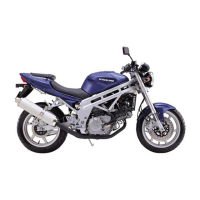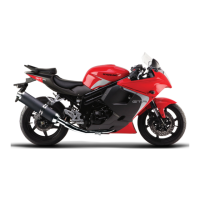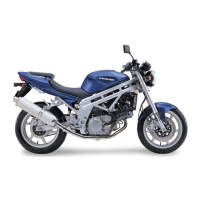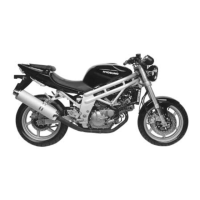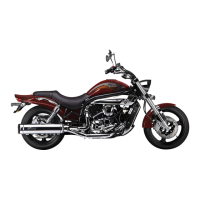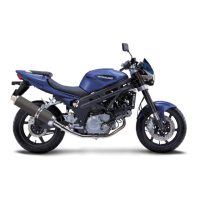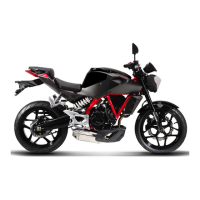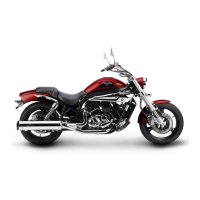Do you have a question about the HYOSUNG GV 650 C and is the answer not in the manual?
Details the steps for initial battery charging required for improved durability.
Outlines the procedure for filling electrolyte, charging, and installing the battery.
Specifies the recommended charging duration and rate for the battery.
Warns about using the battery without initial charging and operating without a battery.
Explains the importance of proper break-in for motorcycle longevity and performance.
Defines the special meanings of signal words used in the manual for emphasis.
Details legal prohibitions against altering the noise control system of the vehicle.
Instructions regarding the maintenance of the exhaust system and spark plug condition.
Provides essential precautions for safe motorcycle operation, including inspections and apparel.
Safety notes on ignition, steering lock, side stand interlock, and rider foot positioning.
Warnings about throttle control, keeping hands on grips, and proper lamp operation.
Cautions against operating the engine indoors and guidelines for long-term storage.
Emphasizes wearing helmets, appropriate protective clothing, and eye protection.
Stresses pre-ride checks and riding within personal skill boundaries to avoid accidents.
Advises extra caution and specific measures for riding in adverse weather conditions.
Guidelines for mounting accessories to maintain stability and avoid handling issues.
Details how accessory weight and electrical additions affect the motorcycle's performance.
Specifies gasoline type and safety precautions during refueling.
Details engine oil grades and viscosity based on temperature.
Specifies coolant mixture, warnings about ingestion, and spillage cautions.
Recommends using only distilled water for coolant mixtures to prevent radiator damage.
Explains the role of coolant and refers to reservoir tank information.
Explains how to use the ignition switch and its positions for starting and stopping.
Details how to lock and unlock the motorcycle's steering.
Provides information about the motorcycle's ignition keys and safe storage.
Describes the function of various indicator lamps and associated warnings.
Details how to read the fuel level indicator and its warnings.
Explains how to view and reset distance traveled on the motorcycle.
Describes the operations of the select and reset switches for various functions.
Explains the function of headlight dimmer, turn signal, and horn switches.
Details the operation of the engine stop switch and throttle grip.
Explains how to use the hazard warning lights and their precautions.
Covers starter switch operation, initial engine start checks, and warnings.
Instructions for adjusting the front brake lever position for rider comfort.
Explains the function of the rear brake pedal and its effect on the brake lamp.
Instructions for exchanging the gearshift link rod for different riding positions.
Explains the side stand interlock system and its safety implications.
Procedures for unlocking and locking the front seat and installing the rear seat.
Guidance on adjusting the rear shock absorber spring pre-load for ride comfort.
Details safety measures and cautions during gasoline refueling.
Step-by-step guide to checking the engine oil level.
Reiterate checking oil level and warn about hot engine components.
Emphasizes using the specified engine oil for optimal performance.
Specifies oil capacity and recommended change intervals.
Warns against overfilling the engine oil to maintain performance.
Advises on safe jacking and oil drainage procedures to prevent damage.
Instructions for draining old engine oil from the crankcase.
Warns about the hazards of new and used engine oil and proper disposal.
Details on removing and installing the engine oil filter.
Ensures correct installation of filter cap, spring, and O-ring.
How to check and refill the coolant reservoir tank.
Advises checking for leaks and reiterates coolant hazards.
Recommends a 50:50 mixture of coolant and water for effectiveness.
Specifies that coolant should be changed every two years.
Provides instructions on how to safely open the radiator cap when the engine is hot.
Step-by-step guide to starting the motorcycle's engine.
Warnings related to the side stand interlock and lamp operation during starting.
Caution against running the engine unnecessarily long without riding.
Details on the correct sequence for starting the engine and related checks.
Warnings about high speeds, side winds, and maintaining control.
Guidance on downshifting and shifting in corners to maintain control.
Recommends gradual throttle application to prevent wheelies.
Techniques for riding on inclines and using engine braking.
Steps for safely stopping the motorcycle and selecting neutral.
Table showing recommended throttle limits during break-in.
Explains why varying engine speed is crucial for proper part seating.
Importance of breaking in new tires for optimal performance and safety.
Advises allowing oil to circulate before applying load to the engine.
Highlights the importance of the first scheduled service for motorcycle longevity.
Stresses the hazardous consequences of failing to inspect the motorcycle.
Details on checking tires, modifications, and overloading risks.
How to check steering, throttle, and clutch operation.
Checking brake systems, suspension, and fuel system integrity.
Verifying bolts, nuts, and overall visible condition.
Lists service intervals and advises more frequent servicing for severe conditions.
Emphasizes specialized service for steering/suspension and using genuine parts.
Lists periodic checks and replacements for engine components.
Lists periodic checks and replacements for chassis components.
Lists the items included in the motorcycle's tool kit.
How to inspect for engine oil, gasoline, and fuel hose leaks.
Inspecting for coolant leaks, radiator damage, and exhaust joint looseness.
Periodic checks of suspension, mirrors, and reflectors.
Notes MF battery type and proper terminal connection.
Warns against incorrect battery cable connections.
Advises on keeping the battery away from fire and proper disconnection/reconnection.
Warns about potential electrical system damage from reversed terminals.
Describes the air cleaner's location and the impact of its condition.
Warns against operating without the element and issues from pollution.
Steps for disassembling the air cleaner cover and element.
Advice on cleaning the element and preventing bypass air.
Instructions for spark plug maintenance and gap adjustment.
Correct torque for installation and recommendations for spark plug types.
Warns about proper tightening to prevent engine damage.
Stresses using recommended spark plugs for optimal performance.
Details how to adjust clutch cable play using adjusters.
What to look for when inspecting the drive belt for wear or damage.
Step-by-step guide to adjusting drive belt slack and wheel alignment.
Advises on inspecting pulleys for wear when replacing the belt.
Detailed steps for adjusting drive belt slack and wheel alignment.
Notes the special material of the drive belt and replacement recommendations.
Warns against bending the drive belt beyond specified limits.
Stresses the need for regular brake system inspection and maintenance.
How to check the brake fluid level in the master cylinder.
Specifies brake fluid type (DOT4) and handling precautions.
How to inspect brake pads for wear down to the limit line.
Checking for fluid leaks and damage to brake hoses.
Ensuring correct operation and replacing worn brake pads.
Checking the brake disk for damage or cracks.
Procedures for replenishing front and rear brake fluid.
Adjusting switches for the front and rear brake lamps.
Importance of proper tire pressure for motorcycle stability and safety.
Table showing recommended tire pressures for solo and dual riding.
How to check tires for visible damage and abnormal wear.
Inspecting tire tread depth and when to replace tires.
Recommended tire sizes and rear axle nut inspection.
Detailed instructions for replacing the front tire.
Detailed instructions for replacing the rear tire.
Warnings and cautions related to changing motorcycle bulbs.
Lists specifications for various motorcycle lamps.
Step-by-step guide for replacing the headlamp bulb.
Instructions for replacing turn signal lamp bulbs.
Details on replacing the brake and tail lamp assembly.
Procedure for replacing the license plate lamp bulb.
Explains fuse box location and cautions against using incorrect fuse ratings.
Initial checks for when the engine does not start.
Steps to test the ignition system for spark.
How to perform a spark test and associated safety warnings.
Common checks for engine stalling, including fuel and idle speed.
Instructions for emptying fuel tank and securing the motorcycle for transport.
Importance of cleaning and warnings against high-pressure washers.
Areas to avoid spraying, safe cleaning methods, and waxing for protection.
Reminds to lubricate after cleaning and check brakes.
Covers cleaning, steering lock, fuel, battery, and tire preparation for storage.
Steps to take after removing the motorcycle from storage.
Safety reminders and a summary of pre-ride inspection items.
Details on recommended tire pressures and sizes.
Information about vehicle manufacturing compliance.
Details of stationary noise test for the GV700C model.
Details of stationary noise test for the GV650C model.
Technical data on physical dimensions, weight, and engine specifications.
Information on clutch, final reduction ratio, and transmission gears.
Data on suspension, electrical components, and capacities.
Technical data on physical dimensions, weight, and engine specifications.
Information on clutch, final reduction ratio, and transmission gears.
Data on suspension, electrical components, and capacities.
| Manufacturer | Hyosung |
|---|---|
| Model | GV 650 C |
| Displacement | 647 cc |
| Bore x Stroke | 81.5 x 62 mm |
| Fuel System | Fuel injection |
| Starting System | Electric |
| Transmission | 5-speed |
| Rear Suspension | Dual shocks |
| Rear Brake | Single disc |
| Engine Type | V-twin, four-stroke |
| Ignition | Digital |
| Frame | Steel |
| Front Suspension | Telescopic fork |
| Front Brake | Dual disc |
| Front Tire | 120/70 |
| Power | 54 kW (73 hp) at 9, 000 rpm |


